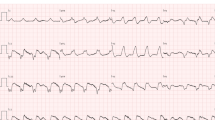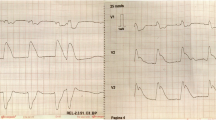Abstract
The most common, clinically significant cause of ST elevation is an angiographically demonstrable occlusive disease due to atherosclerotic changes in coronary artery. Often, a patient presenting with non-specific complaints and ST-segment elevation on the electrocardiogram, is sent for a cardiac catheterization only to see no luminal stenosis on the angiogram. This clinical review is intended to inform emergency medicine physicians and internists about the conditions in which ST-segment elevation is accompanied with no atherosclerotic lesion on coronary angiography. These situations make a diverse array of conditions ranging from anomalous coronaries to anatomically normal coronaries with varied degrees of myocardial injury. These conditions are briefly reviewed in this article.





Similar content being viewed by others
References
Thygesen K, Alpert JS, White HD et al (2007) Universal definition of myocardial infarction. Circulation 116:2634–2653
Waller BF, Fry ET, Hermiller JB et al (1996) Nonatherosclerotic causes of coronary artery narrowing––Part I. Clin Cardiol 19:509–512
Alpert JS (1994) Myocardial infarction with angiographically normal coronary arteries [see comment]. Arch Intern Med 154:265–269
Ammann P, Marschall S, Kraus M et al (2000) Characteristics and prognosis of myocardial infarction in patients with normal coronary arteries. Chest 117:333–338
Surawicz B, Parikh SR (2002) Prevalence of male and female patterns of early ventricular repolarization in the normal ECG of males and females from childhood to old age. J Am Coll Cardiol 40:1870–1876
Klatsky AL, Oehm R, Cooper RA et al (2003) The early repolarization normal variant electrocardiogram: correlates and consequences. Am J Med 115:171–177
Gottschalk CW, Craige E (1956) A comparison of the precordial S–T and T waves in the electrocardiograms of 600 healthy young Negro and white adults. South Med J 49:453–457
Marafioti V, Variola A (2004) Pseudoinfarction pattern by misplacement of electrocardiographic precordial leads. Am J Emerg Med 22:62–63
Van Gelder IC, Crijns HJ, Van der Laarse A et al (1991) Incidence and clinical significance of ST segment elevation after electrical cardioversion of atrial fibrillation and atrial flutter [see comment]. Am Heart J 121:51–56
Kok LC, Mitchell MA, Haines DE et al (2000) Transient ST elevation after transthoracic cardioversion in patients with hemodynamically unstable ventricular tachyarrhythmia. Am J Cardiol 85:878–881
Vikenes K, Omvik P, Farstad M et al (2000) Cardiac biochemical markers after cardioversion of atrial fibrillation or atrial flutter. Am Heart J 140:690–696
Levin DC, Fellows KE, Abrams HL (1978) Hemodynamically significant primary anomalies of the coronary arteries. Angiographic aspects. Circulation 58:25–34
Angelini P (2007) Coronary artery anomalies: an entity in search of an identity. Circulation 115:1296–1305
Irvin RG (1982) The angiographic prevalence of myocardial bridging in man. Chest 81:198–202
Soran O, Pamir G, Erol C et al (2000) The incidence and significance of myocardial bridge in a prospectively defined population of patients undergoing coronary angiography for chest pain. Tokai J Exp Clin Med 25:57–60
Alegria JR, Herrmann J, Holmes DR Jr et al (2005) Myocardial bridging. Eur Heart J 26:1159–1168
Kereiakes DJ, Topol EJ, George BS et al (1991) Myocardial infarction with minimal coronary atherosclerosis in the era of thrombolytic reperfusion. The Thrombolysis and Angioplasty in Myocardial Infarction (TAMI) Study Group. J Am Coll Cardiol 17:304–312
Maseri A, Severi S, Nes MD et al (1978) “Variant” angina: one aspect of a continuous spectrum of vasospastic myocardial ischemia. Pathogenetic mechanisms, estimated incidence and clinical and coronary arteriographic findings in 138 patients. Am J Cardiol 42:1019–1035
Ginsburg R, Schroeder JS, Harrison DC (1982) Coronary artery spasm––pathophysiology, clinical presentations, diagnostic approaches and rational treatment. West J Med 136:398–410
El Menyar AA (2006) Drug-induced myocardial infarction secondary to coronary artery spasm in teenagers and young adults. J Postgrad Med 52:51–56
Stern S, Bayes de Luna A (2009) Coronary artery spasm: a 2009 update. Circulation 119:2531–2534
Sztajzel J, Mach F, Righetti A (2000) Role of the vascular endothelium in patients with angina pectoris or acute myocardial infarction with normal coronary arteries. Postgrad Med J 76:16–21
Tun A, Khan IA (2001) Myocardial infarction with normal coronary arteries: the pathologic and clinical perspectives. Angiology 52:299–304
Korkmaz C, Cansu DU, Kaşifoğlu T (2007) Myocardial infarction in young patients (< or = 35 years of age) with systemic lupus erythematosus: a case report and clinical analysis of the literature. Lupus 16:289–297
Cocco G, Gasparyan AY (2010) Myocardial ischemia in Wegener’s granulomatosis: coronary atherosclerosis versus vasculitis. Open Cardiovasc Med J 4:57–62
Sgarbossa EB, Pinski SL, Barbagelata A et al (1996) Electrocardiographic diagnosis of evolving acute myocardial infarction in the presence of left bundle-branch block. GUSTO-1 (Global Utilization of Streptokinase and Tissue Plasminogen Activator for Occluded Coronary Arteries) Investigators [see comment] [erratum appears in N Engl J Med 1996 Apr 4;334(14):931]. N Engl J Med 334:481–487
Tabas JA, Rodriguez RM, Seligman HK et al (2008) Electrocardiographic criteria for detecting acute myocardial infarction in patients with left bundle branch block: a meta-analysis. Ann Emerg Med 52:329–336 e321
Fahy GJ, Pinski SL, Miller DP et al (1996) Natural history of isolated bundle branch block. Am J Cardiol 77:1185–1190
Guler N, Eryonucu B, Bilge M et al (2001) Wolff-Parkinson-White syndrome mimicking acute anterior myocardial infarction in a young male patient––a case report. Angiology 52:293–295
Goldberger AL (1980) Pseudo-infarct patterns in the Wolff-Parkinson-White syndrome: importance of Q wave-T wave vector discordance. J Electrocardiol 13:115–118
Khan IA, Shaw IS (2000) Pseudo ventricular hypertrophy and pseudo myocardial infarction in Wolff-Parkinson-White syndrome. Am J Emerg Med 18:807–809
Ginzton LE, Laks MM (1982) The differential diagnosis of acute pericarditis from the normal variant: new electrocardiographic criteria. Circulation 65:1004–1009
Mahrholdt H, Goedecke C, Wagner A et al (2004) Cardiovascular magnetic resonance assessment of human myocarditis: a comparison to histology and molecular pathology. Circulation 109:1250–1258
Hunt SA, Abraham WT, Chin MH et al (2009) 2009 Focused update incorporated into the ACC/AHA 2005 Guidelines for the Diagnosis and Management of Heart Failure in Adults A Report of the American College of Cardiology Foundation/American Heart Association Task Force on Practice Guidelines Developed in Collaboration With the International Society for Heart and Lung Transplantation. J Am Coll Cardiol 53:e1–e90
Aziz KU, Patel N, Sadullah T et al (2010) Acute viral myocarditis: role of immunosuppression: a prospective randomised study. Cardiol Young 20:509–515
Sims DB, Sperling LS (2005) Images in cardiovascular medicine. ST-segment elevation resulting from hyperkalemia. Circulation 111:e295–e296
Wang K (2004) Images in clinical medicine. “Pseudoinfarction” pattern due to hyperkalemia. N Engl J Med 351:593
Brugada P, Brugada J (1992) Right bundle branch block, persistent ST segment elevation and sudden cardiac death: a distinct clinical and electrocardiographic syndrome. A multicenter report [see comment]. J Am Coll Cardiol 20:1391–1396
Ozeke O, Aras D, Deveci B et al (2006) Brugada-like early repolarization pattern misdiagnosed as acute anterior myocardial infarction in a patient with myocardial bridging of the left anterior descending artery. Mt Sinai J Med 73:627–630
Lin JF, Li YC, Yang PL (2009) A case of massive pulmonary embolism with ST elevation in leads V1–4. Circ J 73:1157–1159
Sommargren CE, Zaroff JG, Banki N et al (2002) Electrocardiographic repolarization abnormalities in subarachnoid hemorrhage. J Electrocardiol 35(Suppl):257–262
Kawasaki T, Azuma A, Sawada T et al (2002) Electrocardiographic score as a predictor of mortality after subarachnoid hemorrhage. Circulation J 66:567–570
Nakamura Y, Kaseno K, Kubo T (1989) Transient ST-segment elevation in subarachnoid hemorrhage. J Electrocardiol 22:133–137
Azzarelli S, Galassi AR, Amico F et al (2006) Clinical features of transient left ventricular apical ballooning. Am J Cardiol 98:1273–1276
Wittstein IS, Thiemann DR, Lima JAC et al (2005) Neurohumoral features of myocardial stunning due to sudden emotional stress [see comment]. N Engl J Med 352:539–548
Kurisu S, Sato H, Kawagoe T et al (2002) Tako-tsubo-like left ventricular dysfunction with ST-segment elevation: a novel cardiac syndrome mimicking acute myocardial infarction. Am Heart J 143:448–455
Bhadani UK, Tripathi M, Sharma S et al (2006) Scorpion sting envenomation presenting with pulmonary edema in adults: a report of seven cases from Nepal. Indian J Med Sci 60:19–23
Bawaskar HS, Bawaskar PH (1994) Vasodilators: scorpion envenoming and the heart (an Indian experience). Toxicon 32:1031–1040
Bawaskar HS, Bawaskar PH (2003) Clinical profile of severe scorpion envenomation in children at rural setting. Indian Pediatr 40:1072–1075
Engel J, Brady WJ, Mattu A et al (2002) Electrocardiographic ST segment elevation: Left ventricular aneurysm. Am J Emerg Med 20:238–242
Bourassa MG, Butnaru A, Lesperance J, Tardif JC (2003) Symptomatic myocardial bridges: overview of ischemic mechanisms and current diagnostic and treatment strategies. J Am Coll Cardiol 41(3):351–359
Acknowledgments
I thank all my co-authors for their invaluable efforts in success of this review.
Conflict of interest
None.
Author information
Authors and Affiliations
Corresponding author
Rights and permissions
About this article
Cite this article
Chandra, S., Singh, V., Nehra, M. et al. ST-segment elevation in non-atherosclerotic coronaries: a brief overview. Intern Emerg Med 6, 129–139 (2011). https://doi.org/10.1007/s11739-010-0491-5
Received:
Accepted:
Published:
Issue Date:
DOI: https://doi.org/10.1007/s11739-010-0491-5




